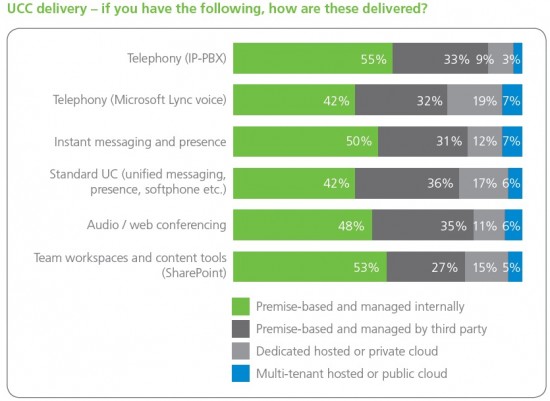































This is the fifth post in a series from Dimension Data and Cisco Channels looking at user adoption and integration of unified communications and collaboration (UC&C) solutions. Findings stem fromDimension Data's 2013 Global UC&C Survey, developed with ICT researcher Ovum and featuring responses from more than 2,700 participants in 18 countries across 20 vertical industries.
In the last blog based on Dimension Data's research, Nagi Kasinadhuni expanded on the idea that certain technologies were merely a ticket to the game. In this edition of the UC&C series, we had the opportunity to interview Neville Cousins, solutions director for voice and applications at Dimension Data. Cousins gave us more insight on the data from the UC&C study from his perspective.
He focused on the idea that the market has seen a slow uptake of cloud deployment. Based on Dimension Data's research the adoption rate has certainly been slower than Cousins would have anticipated.
In looking at the report, you will find that more than half the telephony deployments are premise based and managed by the clients. If you look back at the past ten years, clients have favored having control of the technology and owning the information and being responsible for keeping it up-to-date and managing it. As the transition to cloud has become more and more complicated, clients are having a hard time letting go of control and moving to the cloud, even if it might make perfect sense for them.
According to Cousins, when you look at the combination of different technologies integrating with each other, in different environments, things are actually getting a lot more complicated. Tying those technologies together is not easy. Cousins is seeing, for a number of reasons, clients move more to a managed service approach with a service provider or systems integrator to provide advanced services.
"I think that clients are reacting to the complexity they have created from decisions they've made in the past few years. They have different versions of technology spread across the organization and they might have adopted different technologies in different regions," said Cousins.
He continued, "When I look at a typical, global client that has spent the past four to six years trying to consolidate and simplify at the same time, they haven't made much progress. And largely it's because the approach they are taking combined with the advancement of technology. With video coming along in UC&C, it's getting even more complicated. What we are seeing is them offloading those complex environments onto a managed service where someone else has the skill to make it all work. That is one half of the equation, but we also need to talk about the cloud portion."
According to what Cousins sees in the research, there is a lot of excitement about cloud, but the actual uptake has been quite low. When you look at the actual percentage of the move to the cloud, it's in the lower teens and he would have expected that to have been higher by now.
He believes there are a few reasons why. First there is hesitancy on the part of clients and the enterprise to relinquish control. Clients are hesitant to let go until they are certain they are getting the level of service they expect. He doesn't think it's so much that clients fear losing control of the data. He thinks it is more that they are struggling to justify budgets versus maintaining dedicated resources on their side.
Cousins referred to it as an "operational bind." Clients realize they have staff and they think they can use them in a different way, but they're not quite sure how to do it and they need guidance.
Second, the vendors and service providers have a lot of work to do before clients will get the level of service they expect. Clients want to know that the business is clearly benefiting from the move. They need to be able to show operational benefits and cost savings.
Cousins continued, "There is no doubt there are clients that are starting to understand that the cloud can be a huge differentiator for them, if applied correctly. There are other clients, however, that have done so much on their own, that the benefits of moving now would be incremental. Other than a very, very good financial justification that might exist, there may not be an operational or functional reason to move.
Those clients are going to be very specific about what they do offload to the cloud. My opinion is that managed services are a good space for them to look into. Clients wouldn't have to make one big move all at once. Managed services can really play in that incremental transition. Certainly, we have focused on that space."
If the cloud makes so much sense, why are so many clients doing nothing? Cousins thinks it is because they are not seeing the practical journey of moving from "one side of the mountain to the other" They know they need to move to the other side of the valley, but how exactly do they get there?
"That's where Dimension Data has focused on guiding them to the other side. Some of them know how to do it, but it may not make financial sense. We may be able to show them how it does," said Cousins.
Finally, in his opinion, the three partner takeaways from this take on the research are:
Check back with Cisco and Dimension Data next month for a continued discussion on this research. In the meantime, learn more about Dimension Data's 2013 Global UC&C study. And don't forget to join the conversation; leave a comment below or talk to us on Dimension Data's UC&C Facebook page.
 Tags quentes :
Cisco Partners
#Colaboração
Comunicações Unificadas
dimension data
UC&C
Tags quentes :
Cisco Partners
#Colaboração
Comunicações Unificadas
dimension data
UC&C